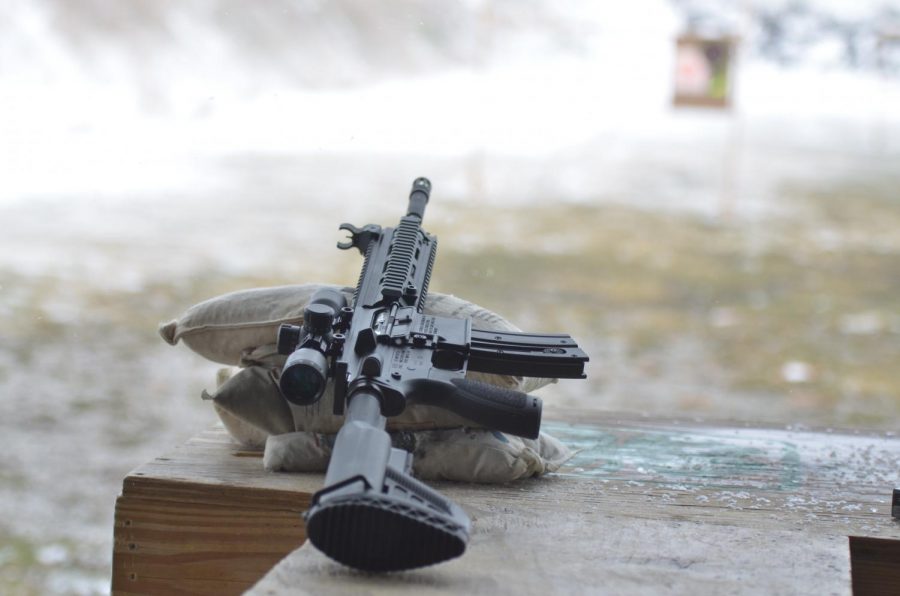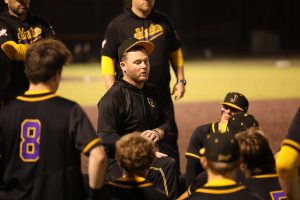Under fire
A look into the controversy surrounding the second amendment.
April 22, 2018
On March 24, I woke up to no less than 16 texts or Snapchats asking what time I would be going down to the capitol to protest for stricter gun control laws. After telling 16 people that I would not be going to the protest, I received 16 replies, varying from confusion to outrage that I could be so heartless.
On April 20, several of my peers felt that it was necessary to question my decision to stay in class during the walkout. After explaining my point of view, I asked them to help me understand their reasons for walking out, and what the walkout hoped to accomplish. A majority of the students that I spoke to did not know what the intended effect of the walkout would be. They knew that they were protesting, but could not explain exactly what policies they want to be implemented in the future. These instances only furthered my observation that many Americans today feel as though it is more important to defend a stance rather than actually forming one on their own. It is much less work to identify with the ideology of one’s peers and defend this point of view through insults than to research both sides of an argument, construct an individual opinion, and then be able to defend it logically rather than spitting out phrases and remarks seen on posters at a protest. This includes, if necessary, being able to explain exactly what should be done and how it should be achieved.
By not agreeing with the same political ideology of my peers, I was somehow infringing on their wellbeing and the efficacy of their voice in our government. Every day at school, the gun control controversy seems to be brought up with increasing frequency, and the discussion following becomes increasingly hostile. In the past couple of months, it has become less of a debate and more of an all-out war. It is no longer the American way to respect the ideas and beliefs of others — unless of course, they agree with you.
As a politically conservative student in a school in which the liberal population has seemed to become increasingly vocal, it has become increasingly difficult to have a conversation with my classmates, peers, and some of my closest friends without a conflict. This is almost always due to the fact that many of my views directly oppose their agendas, and for some reason I always seem to fail to reciprocate their enthusiasm for jumping headfirst into protests, debates and social media ranting by insulting the other side instead of trying to understand a point of view that wasn’t given to them by Twitter, Buzzfeed, or the Huffington Post.
Often times I will ask my classmates about their opinions after our opposing views begin a conversation about the topic of gun control, and they seem offended that I would be so bigoted as to ask them to explain their ideas. Immediately, they begin explaining that I obviously don’t care about the lives of Americans as much as I care about guns and that my opinion means that I must support the murdering of innocent people. Almost every single time, they fail to actually explain why their views are okay and mine are unacceptable. Every argument that I counter is just another reason to get angry and insult me as a person rather than discuss policies, the actual meaning of the laws we have today, and what those laws mean in terms of our rights.
I wouldn’t mind having as many conversations about the rules and policies surrounding firearms in America today as long as those that begin the conversation have also done their homework. I do not wish to stop the conversation if others feel that it is necessary, I am simply wishing that people do enough research on both sides of an issue before tweeting about it. After all, it is easy to support a cause when you do not understand the other point of view. My hope is that anyone reading this will go away with a better understanding of the meaning of the second amendment and how it has been upheld over the years, and maybe even understand why I did not participate in the walkout on April 20.
Some of the most common arguments that I hear about the second amendment itself are about the intent of the founding fathers themselves and the differences in culture from when the amendment was written to the United States today. “The founding fathers didn’t know that we would have the weapons that we have today,” is one of the most repeated, especially when dealing with the topic of semi-automatic rifles and other firearms that have been deemed as “killing machines”. However, when the amendment was written, the founding fathers did not state that the firearms had to be inferior to any others in any respect; in fact, the reason for writing the amendment was to ensure that Americans would forever be given a fair shot at overthrowing a tyrannical government, should the need arise. While it is true that the founding fathers did not know then what guns owned by civilians would look like today, they also had no idea what weapons our government would own either. Had we possessed the technology we have today back in 1776, and the British ensured that the firearms that Americans possessed could in no way hope to compare to their rifles, the idea of the United States of America would have died with the colonists who fought for their freedom.
On the same note, during the time of the revolution, several firearms were used that had a faster rate of fire than the common muskets used. These include a black powder machine gun that merchant ships used along with cannons for protection, and weapons like the pepperbox revolver, which allowed for multiple shots to be fired in a row. All of these were legal and considered necessary for protection, even though they were faster or more powerful than the common musket. The founding fathers were aware that there were significant differences in the types of firearms that civilians could possess, and common sense should have made them realize that it would remain that way in the future. However, this did not impact their decision to secure our right to protect ourselves.
Another statement I hear often is that the second amendment was not intended for civilians to maintain the individual right to keep and bear arms. Many believe that the phrase, “well-regulated militia” in the amendment refers to what we now call the National Guard. The second amendment states, “A well-regulated Militia, being necessary to the security of a free State, the right of the people to keep and bear Arms, shall not be infringed.”
A militia, in legal terms, refers to “The militia of the United States consists of all able-bodied males at least 17 years of age,” according to Subtitle A, Part I, Chapter 12 of United States Code Title 10, which details the definition and rules surrounding the armed forces and military service. This code explains that the United States defines a militia as being any able-bodied male over 17 years old and under 45 (unless previously enlisted in the regular armed forces, in which case the age limit is 64 years old). Section B of the same code explains that there are two classes of militia: organized and unorganized. The organized militia is maintained by the government in what is now called the National Guard. The unorganized militia, however, consists of any and every citizen eligible for the National Guard but has not enlisted, as also supported by the Militia Act of 1792. In other words, the phrase, “well-regulated militia” refers to civilians as much as it does the National Guard.
Eugene Volokh, Professor of law at UCLA, also explained that the founders were, in fact, securing the individual right to bear arms by first of all including the phrase, “the right of the people” and not specifying a right of the state government or an organized militia, and secondly, by including a justification clause in the opening statement. The phrase, “A well-regulated militia” is a justification clause to explain why the right is being secured. In other words, the founding fathers are saying that the people have a right to own guns in order to form a militia to defend the country’s freedom, as also specified in the phrase, “being necessary to the security of a free State”, which describes the purpose of the militia. The right itself is explained in the operative clause “the right of the people to keep and bear arms” before the requirement that it “shall not be infringed.” This was defended in the Supreme Court case “District of Columbia vs Heller”, in which the court stated that the justification clause in the second amendment has no effect on the operative clause. This means that the phrase, “well-regulated militia” is not a definition of the limits and extent of the right, but in fact gives a reason the right is necessary. The right itself, “the right of the people to keep and bear arms” is independent of the justification clause, and therefore is not subject to it.
After researching more about the clauses and true meanings of the second amendment, I began to fact-check everything I saw in the media. Doing so helped me discriminate fact from fiction, and form an educated viewpoint based off of those facts. While fact-checking, I realized how often the media fails to represent both sides of a topic, often not doing enough digging to find out the whole truth. One article that stood out came from the Washington Post, claiming that the “militarization” of police has led to officers becoming more violent. This article cited the AR-15, a civilian rifle, as being a “weapon of war” and claiming that it was used by the United States military. However, after reading up on the topic, I discovered that this myth actually stems from the basic design idea of the AR-15 being adopted by a different manufacturer, who changed the design and made modifications to it, and then made fully-automatic before the military ever used it. In other words, it may look like a combat weapon, but it is about as similar to an M-16 as my Ford Taurus is to the car that the Flintstones “drove”.
Discovering that there is always more to the story has made me realize that many of the people I am debating with do not even know how much there is to learn. When I am discussing my point of view with others, I am often shocked by how little they know about their own stance. My peers and even many of the adults in my life seem to be so preoccupied with telling me how my political affiliations define me, they seem to forget to think about what they believe. My only hope is that before someone tries to tell me that my beliefs are wrong, they do enough research to be able to explain what they believe.







Mary sarrazin • Jun 5, 2018 at 10:29 am
Extremely well researched piece making excellent points. I agree… I wish we could have a conversation about gun laws and gun rights without one side accusing the other side of openly supporting the murder of children. The unfounded (and ridiculous) accusations have to stop if we wish to achieve any sort of solutions to gun violence.